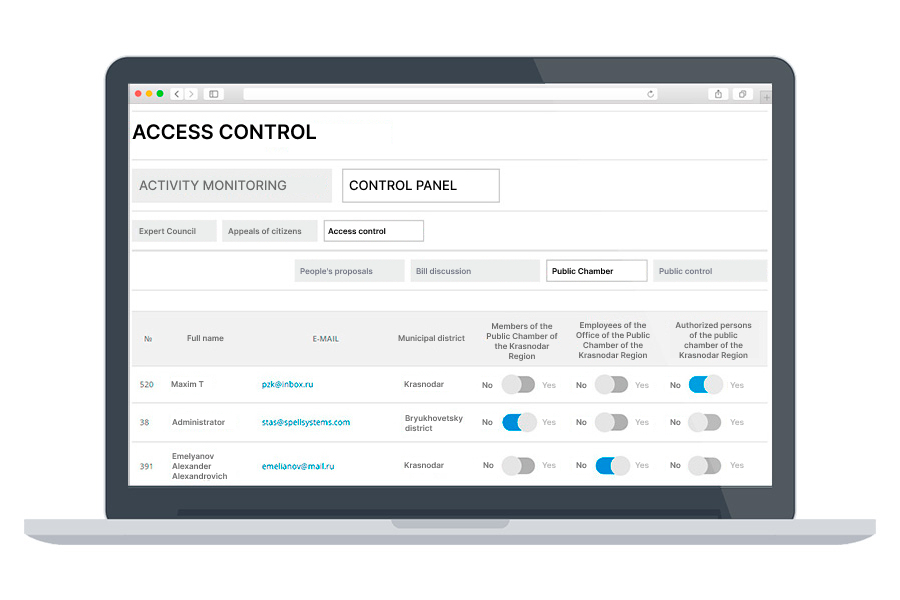About project
Facts
Customer

The government of the Krasnodar Region
Krasnodar region is a federal subject of Russia, located in the Southern Federal District. The region's population is about 5.5 million people on a territory of 75,485 sq. km.
The Region is characterized by industrial and agro-recreational types of development. The basis of the regional productive forces constitutes the industrial, construction and energy complexes, information and communication technologies, as well as agro-industrial, transport, resort and recreation, and tourist complexes. The last three - agriculture, transport, and hotel & tourist complexes - correspond to the priorities of the socio-economic development of Russia and determine the special status of the Krasnodar Krai in the national economy.
Also Krasnodar region city Sochi was the host city of the Winter Olympic Games of 2014.
Goal
The goal is to build up a collaboration platform for citizens, experts, public organizations, unions, and regional and municipal governments where they can communicate, elaborate mutual decisions and bring influence to the regional government politics.
Implementation
Spellsystems has brought to life the regional crowdsourcing network with workflow elements and a regional open-data portal. The workflows in the different subsystems are integrated with the internal document flow systems of regional government departments and municipality departments.
The solution consists of three components:
- An open government social networking portal
- An open data portal
- A mobile application
Open Government Social Networking Portal
This portal provides collaboration functionality, including:
- Law-making and law expertise: This component enables users to initiate and discuss regional and municipal-level regulatory documents. It implements a workflow for multi-stage document development, including the creation of a first concept, discussion of ideas, elaboration of the document body, document expertise, and government reaction control.
- Citizens' control: This component allows citizens to report any issues with city infrastructure. Other users can vote on these issues, which are then transferred to regional or municipal government departments. The government is expected to provide an official response within 10 days. If the issue can be quickly resolved, the responsible department reports the results through the system. If a solution requires more time or a larger budget, the department plans for a future solution and communicates it to the issue creator.
- Construction and development control: The component contains a registry of public constructions in the region. When construction begins, it is added to the registry. Citizens can ask authorities to verify any constructions not in the registry or that seem to differ from published approvals. The results of the verification are always made public in the registry.
- Regional and municipal priority ranks: The component provides a list of regional and municipal development priorities, which users can vote on. The system considers user locations when counting votes and then generates a priority rank for each of the 44 municipalities and a global regional rank. The ranks are updated every three months.
- Government services ratings: The subsystem allows users to evaluate the quality, convenience, and speed of government services. The rankings for government services are updated monthly.
- Suggestions for city problem solutions: The component enables users to suggest solutions for city problems, such as transportation organization or public transport routes.
- Social networking elements, such as user profiles, messaging, publications, and gallery sharing.
Open Data Portal
The open data portal provides a repository of open data that can be accessed visually as a web service. The data includes information from government databases, such as organization structures, staff, document registries, building registries, contact information, and state agencies and companies. Users can view this information in table or map format on the website, and external systems can access the data via XML and JSON. All data sets have passports, and the passport registry for the data sets is published.
The solution consists of three separate parts:
Results
The illegal construction component is designed for collecting, analyzing and visualising information about constructions that have been built without local authorities’ permission. Users can view the data in tables or on the city map. The system also provides an interface for importing the illegal construction registry from an excel file and exporting reports’ data in a pdf file.
Presentation
Technologies
- Apache
- Apache Cordova
- C#
- Java (J2EE)
- Microsoft IIS
- Nginx
- Microsoft Integration Services
- Microsoft SQL Server
- MySQL
- ASP.NET
- JavaScript (jQuery)
- OpenStreetMaps.API
Similar cases studies
The platform aims to support the Governor during the preparation and decision-making process by providing information and expert analysis. It also aims to enhance collaboration and improve efficiency among state executive bodies and municipal authorities.















